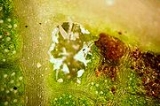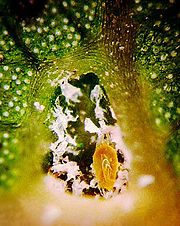
Domatia
Encyclopedia
Domatia are tiny chambers produced by plants that house arthropods.
Domatia differ from gall
s in that they are produced by the plant rather than being induced by their inhabitants. Most domatia are either inhabited by mites
or ants, in what can be a mutualist relationship, but other arthropods such as thrips
may take advantage of the protection offered by this structure.
Domatia occupied by ants are called myrmecodomatia. An important class of myrmecodomatia comprise large, hollow spines of certain acacias such as Acacia sphaerocephala, in which ants of the genera Pseudomyrmex
and Tetraponera
make their nests. Plants that provide myrmecodomatia are called myrmecophyte
s. The variety of the plants that provide myrmecodomatia, and the ranges of forms of such domatia are considerable. Some plants, such as Myrmecodia
, grow large bulbous structures riddled with channels in which their ants may establish themselves, both for mutual protection and for the nutritive benefit of the ants' wastes.
Domatia are often formed on the lower surface of leaves, at the juncture of the midrib and the veins. They usually consist of small depressions partly enclosed by leaf tissue or hairs. Many members of the Lauraceae
family develop leaf domatia. Domatia are also found in some rainforest tree species in the families Alangiaceae
, Elaeocarpaceae
, Fabaceae
, Icacinaceae
, Meliaceae
, Rubiaceae
and Simaroubaceae
.


Domatia differ from gall
Gall
Galls or cecidia are outgrowths on the surface of lifeforms caused by invasion by other lifeforms, such as parasites or bacterial infection. Plant galls are abnormal outgrowths of plant tissues and can be caused by various parasites, from fungi and bacteria, to insects and mites...
s in that they are produced by the plant rather than being induced by their inhabitants. Most domatia are either inhabited by mites
MITES
MITES, or Minority Introduction to Engineering and Science, is a highly selective six-week summer program for rising high school seniors held at the Massachusetts Institute of Technology. Its purpose is to expose students from minority, or otherwise disadvantaged backgrounds, to the fields of...
or ants, in what can be a mutualist relationship, but other arthropods such as thrips
Thrips
Thrips are tiny, slender insects with fringed wings . Other common names for thrips include thunderflies, thunderbugs, storm flies, thunderblights, and corn lice...
may take advantage of the protection offered by this structure.
Domatia occupied by ants are called myrmecodomatia. An important class of myrmecodomatia comprise large, hollow spines of certain acacias such as Acacia sphaerocephala, in which ants of the genera Pseudomyrmex
Pseudomyrmex
Pseudomyrmex is a genus of stinging, wasp-like ants in the family Formicidae . They are large eyed, slender ants with an arboreal habitat. They are found exclusively in the New World in tropical and subtropical regions...
and Tetraponera
Tetraponera
The genus of ants Tetraponera is in the family Formicidae and are characterised by their arboreal nature and slender bodies. There are 86 described species of Tetraponera all of them living in hollow structures of plants and trees, such as thorns or branches, these hosts are known as myrmecophytes...
make their nests. Plants that provide myrmecodomatia are called myrmecophyte
Myrmecophyte
Myrmecophyte is a plant that lives in a mutualistic association with a colony of ants. There are over 100 different genera of myrmecophytes. These plants possess structural adaptations that provide ants with food and/or shelter. These specialized structures include domatia, food bodies, and...
s. The variety of the plants that provide myrmecodomatia, and the ranges of forms of such domatia are considerable. Some plants, such as Myrmecodia
Myrmecodia
Myrmecodia is a genus of epiphytic myrmecophytes native to Southeast Asia and large islands extending south to Queensland in Australia. Myrmecodia plants grow in tree branches and on trunks. In nature, Myrmecodia tubers often grow hanging downward on bare branches without significant amounts of...
, grow large bulbous structures riddled with channels in which their ants may establish themselves, both for mutual protection and for the nutritive benefit of the ants' wastes.
Domatia are often formed on the lower surface of leaves, at the juncture of the midrib and the veins. They usually consist of small depressions partly enclosed by leaf tissue or hairs. Many members of the Lauraceae
Lauraceae
The Lauraceae or Laurel family comprises a group of flowering plants included in the order Laurales. The family contains about 55 genera and over 3500, perhaps as many as 4000, species world-wide, mostly from warm or tropical regions, especially Southeast Asia and South America...
family develop leaf domatia. Domatia are also found in some rainforest tree species in the families Alangiaceae
Alangiaceae
Alangiaceae is a small family of small dicotyledon trees, shrubs or lianas, closely related to the Cornaceae .There is only one genus, Alangium, with seventeen species....
, Elaeocarpaceae
Elaeocarpaceae
Elaeaocarpaceae is a family of flowering plants. The family approximately contains 605 species of trees and shrubs in 12 genera. The largest genera are Elaeocarpus, with about 350 species, and Sloanea, with about 150....
, Fabaceae
Fabaceae
The Fabaceae or Leguminosae, commonly known as the legume, pea, or bean family, is a large and economically important family of flowering plants. The group is the third largest land plant family, behind only the Orchidaceae and Asteraceae, with 730 genera and over 19,400 species...
, Icacinaceae
Icacinaceae
Icacinaceae is a family of flowering plants.It consists of trees, shrubs, and lianas, primarily of the tropics.The family was traditionally circumscribed quite broadly, with around 55 genera totalling over 400 species...
, Meliaceae
Meliaceae
The Meliaceae, or the Mahogany family, is a flowering plant family of mostly trees and shrubs in the order Sapindales....
, Rubiaceae
Rubiaceae
The Rubiaceae is a family of flowering plants, variously called the coffee family, madder family, or bedstraw family. The group contains many commonly known plants, including the economically important coffee , quinine , and gambier , and the horticulturally valuable madder , west indian jasmine ,...
and Simaroubaceae
Simaroubaceae
The Simaroubaceae is a small, mostly tropical, family in the order Sapindales. In recent decades it has been subject to much taxonomic debate, with several small families being split off...
.



